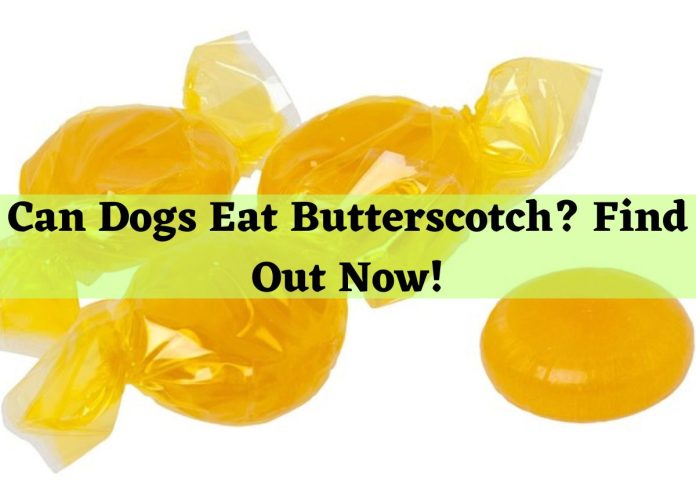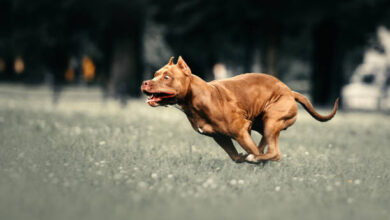Can Dogs Eat Butterscotch? What Every Dog Owner Should Know-2024

Can Dogs Eat Butterscotch? If you’re thinking about sharing this sweet treat with your canine companion, it’s essential to know the facts. Butterscotch is high in sugar and fat, which makes it unsuitable for dogs. Even though it might taste great to us, these ingredients can lead to digestive issues for our furry friends.
Even small amounts of butterscotch can trigger health problems, especially in dogs with sensitive stomachs. As a responsible pet owner, it’s crucial to understand the potential risks before offering any human threats to your dog. Let’s explore the details to keep your pup happy and healthy! Let’s explore that- Can Dogs Eat Butterscotch?
What’s in Butterscotch? Breaking Down the Ingredients
Can Dogs Eat Butterscotch? When considering whether dogs can eat butterscotch, it’s essential to look closely at the ingredients that make up this sweet treat. While humans might enjoy the rich, buttery flavor of butterscotch, many of its components can pose risks to our canine companions. Let’s break down these ingredients to understand the potential effects on dogs.
Sugar
One of the primary ingredients in butterscotch is sugar. While it adds sweetness, it can lead to several health issues in dogs.
- Digestive Problems: Dogs don’t process sugar like humans do, which can lead to gastrointestinal upset.
- Weight Gain: High sugar consumption can contribute to obesity, increasing the risk of related health conditions.
- Diabetes Risk: Frequent intake of sugary treats may raise blood sugar levels and put dogs at risk for diabetes over time.
Butter and Cream
Another key ingredient in butterscotch is butter and cream, both of which are high in fat.
- Digestive Issues: The high-fat content can be tough on a dog’s digestive system, leading to upset stomach, vomiting, or diarrhea.
- Pancreatitis Risk: Consuming fatty foods can trigger pancreatitis, a painful inflammation of the pancreas that can be serious or even life-threatening.
Potential Additives
Butterscotch often contains artificial flavors or preservatives to enhance taste and shelf life.
- Harmful Chemicals: Some of these additives can irritate a dog’s digestive system or cause allergic reactions.
- Long-Term Health Effects: Regular consumption of artificial ingredients may lead to chronic health issues over time.
Salt (If Included)
In some recipes, salt may be added to enhance flavor.
- Dehydration: High salt content can lead to increased thirst and dehydration in dogs.
- Kidney Strain: Excessive salt can put additional strain on a dog’s kidneys, potentially leading to long-term health problems.
Can Dogs Eat Butterscotch? While butterscotch may be a delicious treat for humans, the ingredients within it pose various risks for dogs. The sugar, high-fat content from butter and cream, potential harmful additives, and added salt can all lead to serious health concerns. For these reasons, it’s best to avoid giving your dog butterscotch and instead opt for safer, dog-friendly treats.
Why Butterscotch Can Be Harmful for Dogs-Can Dogs Eat Butterscotch?
Can Dogs Eat Butterscotch? When it comes to sharing treats with our furry friends, it’s crucial to know which foods are safe and which can be harmful. Many pet owners may wonder, can dogs eat butterscotch? The answer is no, and for good reason. Butterscotch is loaded with ingredients that can negatively impact a dog’s health. Let’s explore why this sweet treat can be harmful to dogs and what potential health risks it poses.
Digestive Upset
One of the primary concerns when dogs consume butterscotch is the potential for digestive upset.
- Sugar Sensitivity: Dogs have difficulty digesting sugar, leading to symptoms such as diarrhea, vomiting, or gas.
- Fat Content: The high-fat ingredients in butterscotch can also contribute to gastrointestinal distress, making your dog uncomfortable.
Obesity and Weight Gain
Regularly indulging in sugary treats like butterscotch can lead to significant weight issues in dogs.
- Caloric Density: Butterscotch is calorie-dense, and the sugar can lead to increased fat accumulation.
- Health Risks: Obesity in dogs is associated with various health problems, including joint issues, heart disease, and a shorter lifespan.
Pancreatitis Risk
High-fat foods are particularly dangerous for dogs, and butterscotch falls into this category.
- Inflammation of the Pancreas: Consuming rich, fatty foods can trigger pancreatitis, a painful condition that can be serious and requires immediate veterinary attention.
- Symptoms: If your dog shows signs of abdominal pain, vomiting, or lethargy after consuming high-fat foods, it’s essential to seek veterinary care.
Diabetes Concerns
The sugar content in butterscotch can raise red flags regarding diabetes risk for dogs.
- Elevated Blood Sugar Levels: Dogs that consume too much sugar can develop insulin resistance over time, leading to diabetes.
- Long-Term Effects: Chronic high sugar intake can result in weight gain and metabolic issues, increasing the likelihood of developing diabetes.
Can Dogs Eat Butterscotch? The question of whether dogs can eat butterscotch should be a resounding no. The risks associated with digestive upset, obesity, pancreatitis, and diabetes far outweigh any momentary enjoyment your dog might experience from this sugary treat. It’s always best to stick to dog-friendly snacks that promote their health and well-being.
Signs Your Dog Ate Butterscotch: Symptoms to Watch For
Can Dogs Eat Butterscotch? As dog owners, it’s essential to be vigilant about what our pets consume. If you’ve ever wondered, can dogs eat butterscotch? it’s crucial to understand the signs that might indicate your dog has ingested this sugary treat. Butterscotch can lead to various health issues, and recognizing the symptoms early can help you take the necessary steps to ensure your dog’s well-being. Here are the key signs to watch for if you suspect your dog has eaten butterscotch.
Stomach Upset
One of the most immediate reactions your dog may have after eating butterscotch is gastrointestinal discomfort.
- Vomiting: This can be a common response as the dog’s stomach tries to rid itself of an irritant.
- Diarrhea: High sugar and fat content can disrupt your dog’s digestive system, leading to loose stools.
- Bloating: If your dog’s abdomen appears distended or they seem uncomfortable, it could indicate gas buildup.
Lethargy
If your dog seems unusually tired after consuming butterscotch, this could be a sign of distress.
- Sudden Tiredness: A noticeable drop in energy levels may suggest that your dog is experiencing digestive discomfort or is feeling unwell.
- Lack of Interest in Activities: If your dog usually enjoys playing but suddenly seems disinterested, it may be due to the aftereffects of butterscotch.
Increased Thirst
Another common symptom of eating sugary treats like butterscotch is excessive thirst.
- Dehydration Signs: The sugar content can lead to dehydration, prompting your dog to drink more water than usual.
- Frequent Drinking: If you notice your dog is seeking water frequently, it may be their way of combating the effects of the sugar.
Abdominal Pain
If your dog exhibits signs of abdominal discomfort, it’s important to pay close attention.
- Signs of Pain: Watch for behaviors such as pacing, whining, or reluctance to lie down.
- Contact Your Vet: If you suspect your dog is in pain, especially after consuming butterscotch, don’t hesitate to reach out to your veterinarian for advice.
Can Dogs Eat Butterscotch? Knowing the signs your dog ate butterscotch can help you respond quickly to any health issues that may arise. Symptoms like stomach upset, lethargy, increased thirst, and abdominal pain should not be taken lightly. If you observe any of these signs after your dog consumes butterscotch, it’s important to monitor their condition closely and consult your veterinarian if necessary. Your dog’s health and happiness are what matter most!
Healthier Alternatives to Butterscotch for Dogs
Can Dogs Eat Butterscotch? When it comes to treating our furry friends, it’s important to choose snacks that are both safe and nutritious. If you’re pondering can dogs eat butterscotch, the answer leans towards no, as this sugary treat can pose health risks to dogs. Thankfully, there are plenty of healthier alternatives that will satisfy your dog’s taste buds without compromising their health. Let’s explore some dog-friendly options you can offer instead of butterscotch.
Dog-Safe Fruits
Fruits can be a delicious and healthy treat for your pup.
- Blueberries: These little berries are packed with antioxidants and are low in calories, making them a fantastic snack.
- Strawberries: Not only do they provide vitamins, but they also have a natural sweetness that many dogs love.
- Apple Slices: Always remember to remove the seeds! Apple slices can be a crunchy, satisfying treat for dogs.
Low-Calorie Dog Treats
If you’re looking for something specifically formulated for dogs, low-calorie treats are a great choice.
- Commercial Options: Many brands offer treats that are low in sugar and calories, designed to keep your dog healthy while still enjoying a tasty reward.
- Check Ingredients: Always read the label to ensure they don’t contain harmful additives.
Plain Pumpkin or Sweet Potato
Both pumpkin and sweet potato are excellent choices that can be enjoyed by dogs.
- Natural Sweetness: They provide a sweet flavor without the added sugars found in butterscotch.
- Health Benefits: These foods are rich in fiber, which can aid in digestion and promote overall health.
Homemade Dog Treats
If you enjoy baking, consider making your own dog treats using safe ingredients.
- Peanut Butter: Ensure it’s unsweetened and xylitol-free. Peanut butter can be mixed with whole wheat flour to create delicious treats.
- Banana: Mashed banana can be a great ingredient for dog treats, providing natural sweetness and essential nutrients.
Can Dogs Eat Butterscotch? If you’re wondering about the healthier alternatives to butterscotch for dogs, there are plenty of options available that your furry friend will love. From dog-safe fruits like blueberries and strawberries to low-calorie commercial treats, plain pumpkin, and even homemade goodies, you can provide delicious snacks that are much better for your dog’s health. Always prioritize your dog’s well-being by choosing treats that support their nutritional needs!
Keeping Butterscotch Out of Your Dog’s Reach
Can Dogs Eat Butterscotch? As dog owners, it’s our responsibility to ensure our pets stay safe from harmful foods, and butterscotch is one such treat that should be kept away from their curious noses and paws. Here are some effective strategies to help keep butterscotch and other sugary snacks out of your dog’s reach.
Store Candy Safely
Proper storage of sweets is crucial to prevent your dog from sneaking a taste.
- High Cabinets: Place butterscotch and other candies in high cabinets that your dog cannot access.
- Locked Containers: Consider using locked containers for added security, especially if your dog is particularly clever or determined.
Educate Family and Friends
It’s important to communicate with everyone in your household about your dog’s dietary restrictions.
- Reminders: Regularly remind family and friends not to share human treats with your dog. Educate them on the potential dangers of feeding dogs sugary snacks like butterscotch.
- Clear Communication: Make it clear that while your dog may beg for a treat, their health should always come first.
Dispose of Wrappers Properly
Dogs are often attracted to wrappers, thinking there might be food inside.
- Secure Disposal: After enjoying butterscotch, make sure to dispose of wrappers securely in a trash can with a lid.
- Out of Reach: Keep trash cans out of reach or in cabinets to prevent your dog from rummaging through them.
Have Dog-Friendly Treats On Hand
Offering your dog safe treats can help deter them from seeking out human snacks.
- Accessibility: Keep a stash of dog-safe treats in convenient places so you can reward your dog without resorting to butterscotch or other human foods.
- Variety: Provide a variety of healthy options, such as fruits, veggies, and low-calorie dog treats, to keep your pup happy and satisfied.
Conclusion
By implementing these strategies, you can effectively keep butterscotch and other harmful sweets away from your dog while still rewarding them with tasty, safe alternatives. Remember, a little prevention goes a long way in ensuring your dog’s health and well-being!



